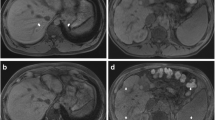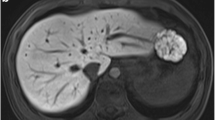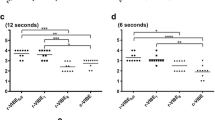Abstract
Purpose
We examined whether the shortened breath-hold 3-dimensional volumetric interpolated breath-hold examination (3D-VIBE) sequence for high acceleration factor (AF) using the controlled aliasing in parallel imaging results in higher acceleration (CAIPIRINHA) could substitute for the conventional sequence using generalized autocalibrating partially parallel acquisition (GRAPPA) in patients undergoing routine gadoxetic acid-enhanced liver MRI.
Materials and methods
Thirty patients with clinically suspected focal liver lesions were scanned using 3D-VIBE sequences with GRAPPA with AF = 2 and AF = 4 and CAIPIRINHA with AF = 4 (acquisition times: 21, 14, and 12 s, respectively) during the hepatobiliary phase. Visual evaluations using a 3- or 5-point scale and signal-to-noise ratio (SNR) analysis were performed for the 3 sequences.
Results
For CAIPIRINHA with AF = 4, there was significantly less image noise in both visual evaluation and SNR analysis and fewer parallel imaging artifacts than for GRAPPA with AF = 4 (P < 0.0005); it was equal to GRAPPA with AF = 2 and had fewer motion artifacts than GRAPPA with AF = 2 and 4 (P < 0.0012). The liver edge sharpness and hepatic vessel clarity, lesion conspicuity, and overall image quality were rated significantly higher with CAIPIRINHA with AF = 4 than GRAPPA with AF = 2 and AF = 4 (P < 0.009). For GRAPPA with AF = 4, lesion conspicuity and overall image quality were rated significantly lower than for GRAPPA with AF = 2 (P < 0.012).
Conclusion
The shortened breath-hold 3D-VIBE sequence using the new CAIPIRINHA technique with a high AF of 4 was superior to the conventional GRAPPA sequence. The shortened breath-hold sequence using GRAPPA with a high AF of 4 worsened the image quality and lesion conspicuity.




Similar content being viewed by others
References
Lee VS, Lavelle MT, et al. (2000) Hepatic MR imaging with a dynamic contrast-enhanced isotropic volumetric interpolated breath-hold examination: feasibility, reproducibility, and technical quality. Radiology 215(2):365–372. doi:10.1148/radiology.215.2.r00ma16365
Riffel P, Attenberger UI, Kannengiesser S, et al. (2013) Highly accelerated T1-weighted abdominal imaging using 2-dimensional controlled aliasing in parallel imaging results in higher acceleration: a comparison with generalized autocalibrating partially parallel acquisitions parallel imaging. Invest Radiol 48(7):554–561. doi:10.1097/RLI.0b013e31828654ff
Yoon JH, Lee JM, Yu MH, et al. (2014) High-resolution T1-weighted gradient echo imaging for liver MRI using parallel imaging at high-acceleration factors. Abdom Imaging 39(4):711–721. doi:10.1007/s00261-014-0099-8
Yu MH, Lee JM, Yoon JH, et al. (2013) Clinical application of controlled aliasing in parallel imaging results in a higher acceleration (CAIPIRINHA)-volumetric interpolated breathhold (VIBE) sequence for gadoxetic acid-enhanced liver MR imaging. J Magn Reson Imaging 38(5):1020–1026. doi:10.1002/jmri.24088
Zech CJ, Herrmann KA, Reiser MF, Schoenberg SO (2007) MR imaging in patients with suspected liver metastases: value of liver-specific contrast agent Gd-EOB-DTPA. Magn Reson Med Sci 6(1):43–52.
Akai H, Kiryu S, Matsuda I, et al. (2011) Detection of hepatocellular carcinoma by Gd-EOB-DTPA-enhanced liver MRI: comparison with triple phase 64 detector row helical CT. Eur J Radiol 80(2):310–315. doi:10.1016/j.ejrad.2010.07.026
Muhi A, Ichikawa T, Motosugi U, et al. (2011) Diagnosis of colorectal hepatic metastases: comparison of contrast-enhanced CT, contrast-enhanced US, superparamagnetic iron oxide-enhanced MRI, and gadoxetic acid-enhanced MRI. J Magn Reson Imaging 34(2):326–335. doi:10.1002/jmri.22613
Wright KL, Harrell MW, Jesberger JA, et al. (2014) Clinical evaluation of CAIPIRINHA: comparison against a GRAPPA standard. J Magn Reson Imaging 39(1):189–194. doi:10.1002/jmri.24105
Pruessmann KP, Weiger M, Scheidegger MB, Boesiger P (1999) SENSE: sensitivity encoding for fast MRI. Magn Reson Med 42(5):952–962. doi:10.1002/(SICI)1522-2594
Glockner JF, Hu HH, Stanley DW, Angelos L, King K (2005) Parallel MR imaging: a user’s guide. Radiographics 25(5):1279–1297. doi:10.1148/rg.255045202
Vogt FM, Antoch G, Hunold P, et al. (2005) Parallel acquisition techniques for accelerated volumetric interpolated breath-hold examination magnetic resonance imaging of the upper abdomen: assessment of image quality and lesion conspicuity. J Magn Reson Imaging 21(4):376–382. doi:10.1002/jmri.20288
Yutzy SR, Seiberlich N, Duerk JL, Griswold MA (2011) Improvements in multislice parallel imaging using radial CAIPIRINHA. Magn Reson Med 65(6):1630–1637. doi:10.1002/mrm.22752
Park YS, Lee CH, Kim IS, et al. (2014) Usefulness of controlled aliasing in parallel imaging results in higher acceleration in gadoxetic acid-enhanced liver magnetic resonance imaging to clarify the hepatic arterial phase. Invest Radiol 49(3):183–188. doi:10.1097/RLI.0000000000000011
Breuer FA, Blaimer M, Heidemann RM, et al. (2005) Controlled aliasing in parallel imaging results in higher acceleration (CAIPIRINHA) for multi-slice imaging. Magn Reson Med 53(3):684–691. doi:10.1002/mrm.20401
Morani AC, Vicens RA, Wei W, et al. (2015) CAIPIRINHA-VIBE and GRAPPA-VIBE for liver MRI at 1.5 T: a comparative in vivo patient study. J Comput Assist Tomogr 39(2):263–269. doi:10.1097/RCT.0000000000000200
Motulsky H (1997) Appropriate simple size. In: Motulsky H (ed) trans Intuitive biostatics. Tokyo: Science Medical, pp 196–205
Kitoh Y, Imai H, Miyati T, et al. (2012) Effects of region of interest settings in signal-to-noise ratio measurement of clinical images using arrays of multiple receiver coils. Nihon Hoshasen Gijutsu Gakkai Zasshi 68(9):1269–1278
Dietrich O, Raya JG, Reeder SB, Reiser MF, Schoenberg SO (2007) Measurement of signal-to-noise ratios in MR images: influence of multichannel coils, parallel imaging, and reconstruction filters. J Magn Reson Imaging 26(2):375–385. doi:10.1002/jmri.20969
Tanimoto A, Higuchi N, Ueno A (2012) Reduction of ringing artifacts in the arterial phase of gadoxetic acid-enhanced dynamic MR imaging. Magn Reson Med Sci 11(2):91–97
Author information
Authors and Affiliations
Corresponding author
Rights and permissions
About this article
Cite this article
Ogawa, M., Kawai, T., Kan, H. et al. Shortened breath-hold contrast-enhanced MRI of the liver using a new parallel imaging technique, CAIPIRINHA (controlled aliasing in parallel imaging results in higher acceleration): a comparison with conventional GRAPPA technique. Abdom Imaging 40, 3091–3098 (2015). https://doi.org/10.1007/s00261-015-0491-z
Published:
Issue Date:
DOI: https://doi.org/10.1007/s00261-015-0491-z




